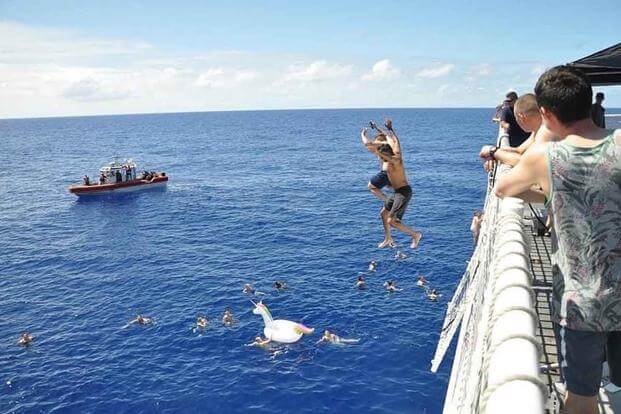The U.S. Coast Guard doesn't care whether you consider it a branch of the military or not. It considers itself America's Oldest Maritime Defender and has the artifacts to prove it.
On the official Coast Guard Instagram account, Coasties started to show off some of the most interesting items in the service's New London, Connecticut, museum (which has its own Instagram account), and the results were, frankly, awesome.
Founded in 1790, the Coast Guard has taken part in every major American conflict since. In that time, it has had a major impact on American military history. Almost every U.S. military branch would be forever adversely affected had there been no Coast Guard.
The museum, occupying a small section of the Coast Guard Academy, showcases a few incredible historical artifacts that illustrate why the service deserves your respect.
1. The Japanese Surrender Sword
On Sept. 2, 1945, the Japanese government signed the official surrender documents aboard the USS Missouri, ending the Pacific War between the Allies and Imperial Japan. Army Gen. Douglas MacArthur, representing the United States, was presented with a 16th-century sword by one of the Japanese admirals in attendance.

MacArthur gave the sword to the Coast Guard to recognize its contribution to winning World War II in the Pacific.
2. Douglas Munro's Medal of Honor
On Sept. 27, 1942, Coast Guard Signalman 1st Class Douglas Munro saved 500 Marines at Guadalcanal by using his Higgins boat as a shield to protect them as they got off the beach. At age 22, he gave his life to protect Marines he didn't know -- including Lt. Col. Lewis "Chesty" Puller.

Munro was awarded the Medal of Honor for that action, becoming the only Coastie ever to receive the U.S.'s highest award for combat. His mother Edith would later donate it to the Coast Guard Academy, which gave it to the museum. You're welcome, Marines.
3. Joshua James' Lifesaving Medals
People like Joshua James exist because even heroes need rescuing from time to time. James was a member of one of the modern Coast Guard's precursor entities, the U.S. Life-Saving Service and, boy, did he do the job. Between the ages of 15 and 75, James rescued more than 500 people, many in the middle of hurricanes.

For his daring rescues, James earned Gold Lifesaving Medals the way some of us earn extra cash as Uber drivers. The Coast Guard Museum has many, but not all, of them, presumably because somewhere Scrooge McDuck is swimming through a vault filled with them.
4. Capt. David H. Jarvis' Haunted Coffee Cup
In a story from another of the Coast Guard's precursor organizations, the U.S. Revenue Cutter Service, Capt. David H. Jarvis headed a three-man team that saved 265 stranded whalers whose ship was trapped in ice by leading a herd of reindeer 1,500 miles across the frozen wastes of 1898 Alaska to feed the sailors until the ice melted.

Jarvis died by suicide in 1911, and his cup is believed to be haunted. According to the museum, "Legend states that if this cup is tipped over, dropped, or turned upside down, a Coast Guard cutter will sink."
The cup is now stored in a small wooden box with a viewing window.
5. Fossilized Cribbage Boards
Speaking of reindeer, the State of Alaska might not ever have come to be if it weren't for the Coast Guard. The U.S. Revenue Cutter Service's own Capt. "Hell Roarin'" Mike Healy -- also the first African-American to command a U.S. government ship -- imported reindeer from Siberia as a steady source of food for the growing number of Americans living in Alaska.

The Coast Guard Museum boasts a number of old trinkets, scrimshaw and cribbage boards carved and designed out of ivory, tusks and even fossilized animal penises.
6. Salty the Lucky Rabbit
A Guardsman aboard the World War II-era Coast Guard Cutter Ingham purchased a toy rabbit for his children while stationed in England. It didn't take long for Coasties to see the toy rabbit as a good luck charm for the whole boat, dubbing him "Salty" -- presumably for obvious reasons.

The Ingham is the only cutter ever to receive two Presidential Unit Citations. Its September 1942 sinking of U-626 made the cutter the last active warship in the U.S. fleet with a U-Boat kill when it was decommissioned in 1988.
7. The Cutter Kimball's Unicorn Float
During a swim call in Pacific Oceania, the crew of the cutter Kimball needed to be rescued when an 8-foot shark joined the Coasties in their recreational fun. Left behind when the crew rejoined the ship was a white and multicolored unicorn floatie.

Watch: Coast Guard Watch Opens Fire After 8-Foot Shark Crashes Swim Call
Rather than shoot the unicorn or leave it adrift, the Coasties hoisted it back aboard the Kimball, where the crew eventually signed it and handed it over to the Coast Guard Museum, joining Salty the Rabbit and other Coast Guard mascots.
-- Blake Stilwell can be reached at blake.stilwell@military.com. He can also be found on Twitter @blakestilwell or on Facebook.
Want to Learn More About Military Life?
Whether you're thinking of joining the military, looking for post-military careers or keeping up with military life and benefits, Military.com has you covered. Subscribe to Military.com to have military news, updates and resources delivered directly to your inbox.










